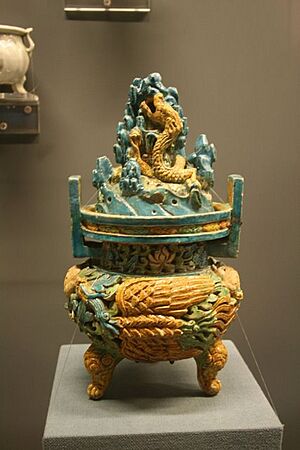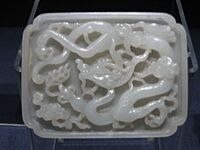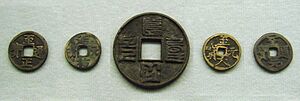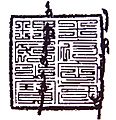History of the Yuan dynasty facts for kids
The Yuan dynasty (1271–1368) was a powerful time in Chinese history. It was ruled by the Mongols, a group of people from Central Asia, and was founded by the famous leader Kublai Khan. The Yuan dynasty is seen as one of the important parts of the larger Mongol Empire.
Contents
How the Yuan Dynasty Began
Kublai Khan's Rise to Power
Genghis Khan was a great leader who united many Mongol and Turkic tribes in 1206. He and his family then built a huge Mongol Empire across Asia. Later, under Genghis' grandson, Ögedei Khan, the Mongols defeated the Jin dynasty in 1234. This helped them take control of most of northern China.
Kublai Khan, another grandson of Genghis, was given control over Mongol lands in China. Even though he couldn't read Chinese, he had Chinese teachers and learned a lot from Chinese advisors. He started schools, used paper money, and encouraged farming and trade. He made a city called Kaiping in Inner Mongolia his capital, which was later renamed Shangdu.
Many Chinese and Khitan people joined the Mongols to fight against the Jin. They even formed their own armies within the Mongol forces.
In 1251, Möngke Khan became the Great Khan. He started a big military campaign against the Song dynasty in southern China. But he died in 1259 without choosing who would rule next.
Kublai Khan quickly returned from fighting the Song when he heard his brother, Ariq Böke, wanted to be the next Great Khan. Kublai gathered his supporters in China and they chose him as the Great Khan. But Ariq Böke's supporters in Mongolia also chose him, starting a civil war. Kublai won this war in 1264 because he had strong support from his Chinese subjects. He made his government similar to traditional Chinese dynasties to gain more popularity. This civil war, however, permanently split the Mongol Empire into different parts.
The conflicts between Kublai Khan and other Mongol leaders in Central Asia lasted for many years. Even though the Mongol Empire was divided, the other parts eventually recognized Kublai's family as the main leaders after a while.
Starting the Yuan Dynasty
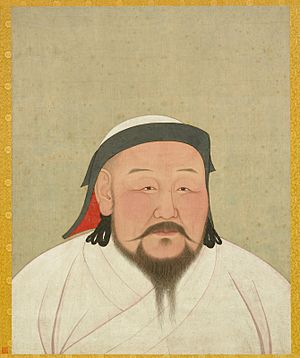
Kublai Khan faced some challenges early in his rule. A powerful official's son-in-law, Li Tan, started a rebellion in 1262. After stopping it, Kublai became more careful about relying too much on Chinese officials. He wanted to make sure his government was strong and stable.
He made some important changes, like making the government more centralized and using more paper money. He also kept the government's control over important goods like salt and iron. However, he didn't bring back the traditional Chinese exams for government jobs right away.
In 1266, Kublai ordered the building of his new capital city. This city, known as Khanbaliq (or Dadu to the Chinese), is now the center of modern-day Beijing. In 1271, Kublai Khan officially announced the start of the new Yuan dynasty. He claimed that his dynasty had the "Mandate of Heaven," which meant he had the right to rule all of China. This was special because it was the first time a non-Chinese family ruled all of China.
The name "Da Yuan" (meaning "Great Yuan") came from an old Chinese book called the I Ching. It was the first Chinese dynasty to use "Great" in its name and not be named after a region or noble title.
In the 1270s, Kublai began a huge effort to conquer the Song dynasty in southern China. His navy blocked the Yangzi River, and his army captured important cities. By 1276, most of the Song territory was under Yuan control. Finally, in 1279, the Yuan army won the Battle of Yamen, ending the Song dynasty. This meant China was united again after hundreds of years of being divided.
After uniting China, Kublai Khan was encouraged to expand his empire even further. However, his attempts to invade Japan (twice), Vietnam (twice), and Java were not very successful. He did set up a friendly government in Myanmar. Some countries like Vietnam later agreed to have a friendly relationship with the Yuan dynasty to avoid more fighting.
Kublai Khan's Rule
Kublai Khan was a strong emperor who made many changes to China. He made the government more centralized, meaning he had more absolute power. He divided his empire into large areas called provinces, which became a model for later Chinese dynasties. He also reformed the tax system and other government and economic rules.
Kublai understood that to rule China well, he needed Chinese advisors and officials. However, Mongols held most of the important jobs. People were generally divided into four classes: Mongols, Semu (people from Central Asia), Northerners (Chinese from the north), and Southerners (Chinese from the south). Mongols had the most privileges.
Kublai Khan built the capital city of Khanbaliq (Beijing) and made Shangdu his summer capital. He also improved farming by extending the Grand Canal and building highways and public grain storage places. Marco Polo, a merchant from Venice who worked for Kublai Khan, said that Kublai was a kind ruler. He helped people during hard times, built hospitals and orphanages, and gave food to the poor.
Kublai also supported science and different religions. He strongly encouraged trade along the Silk Road, which helped Chinese ideas and technologies spread to the West. Marco Polo's father and uncle had met Kublai Khan before. Kublai was interested in the Christian world and wanted to invite missionaries. Marco Polo later traveled throughout Kublai's empire for 17 years. Marco Polo's stories later inspired explorers like Christopher Columbus.
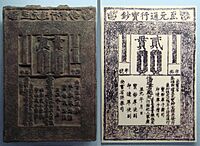
In 1273, Kublai started issuing paper banknotes called Jiaochao. While paper money had been used in China before, the Yuan dynasty was the first to use it as the main form of money. Yuan officials made these paper bills from mulberry tree bark.
Even though Kublai Khan was seen as the main leader of the Mongol Empire, he focused mostly on China. By the time he died in 1294, the other parts of the Mongol Empire were mostly independent. Kublai Khan was given the temple name Shizu.
Early Rulers After Kublai
After Kublai Khan, choosing the next emperor became a big problem, leading to many struggles. Kublai had chosen his eldest son, Zhenjin, to be the next ruler, but Zhenjin died before him. So, Zhenjin's third son, Temür Khan (Emperor Chengzong), became emperor in 1294 and ruled for about 10 years. Temür Khan tried to continue many of Kublai's policies. He also made peace with other Mongol groups and neighboring countries like Vietnam. However, corruption in the Yuan dynasty started to grow during his rule.
Külüg Khan (Emperor Wuzong) became emperor after Temür Khan. He didn't continue Kublai's work and made some changes, including new money policies. During his short rule (1307-1311), the government faced financial problems, and people became unhappy.
The fourth Yuan emperor, Ayurbarwada Buyantu Khan, was a good leader. He was the first Yuan emperor after Kublai to strongly support and adopt traditional Chinese culture. He made many reforms, including bringing back the traditional imperial examinations in 1313. These exams tested people's knowledge of history and helped choose officials. He also wrote down many laws and translated Chinese books.
His son, Gegeen Khan, continued his father's policies to improve the government based on Confucian ideas. During his rule, a huge collection of Yuan dynasty laws and rules was officially published.
Later Years of the Dynasty
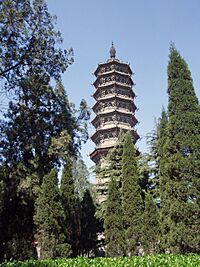
The last years of the Yuan dynasty were difficult. There were struggles, famines, and a lot of unhappiness among the people. Over time, Kublai Khan's successors lost their influence over other Mongol lands. They also started losing their power in China. The later Yuan emperors ruled for short periods and often faced plots and rivalries. They became less interested in governing and were separated from the army and the people. China faced a lot of unrest, and outlaws roamed the country without much resistance from the weakening Yuan armies.
Gegeen Khan ruled for only two years (1321-1323) before being killed in a coup by five princes. They put Yesün Temür on the throne. Before this, China had been relatively peaceful since Kublai's time. But now, control started to break down, especially in areas with ethnic minorities. These revolts made the government's financial problems even worse.
When Yesün Temür died in 1328, a civil war broke out over who would be the next emperor. Jayaatu Khan Tugh Temür eventually won and became Emperor Wenzong. He tried to get other Mongol leaders to accept him as the main ruler. However, he was largely controlled by a powerful official named El Temür. This official's harsh rule clearly showed the decline of the dynasty.
Despite being a puppet ruler, Tugh Temür is known for his contributions to culture. He honored Confucianism and promoted Chinese cultural values. He founded an academy to help teach Confucian culture to the Mongol royal family. This academy compiled and published many books. He also supported Neo-Confucianism and was interested in Buddhism.
After Tugh Temür died in 1332, the 13-year-old Toghon Temür (Emperor Huizong) became the last of Kublai Khan's successors to rule. Another powerful official, Bayan, controlled the court for a while. But Toghon Temür eventually removed Bayan from power. Toghon Temür then tried to improve the government. One of his successes was finishing the official histories of the Liao, Jin, and Song dynasties in 1345.
From the late 1340s, people in the countryside suffered from natural disasters like droughts and floods, which led to famines. The government didn't do enough to help, and it lost public support. In 1351, the Red Turban Rebellion began, growing into a huge uprising across the country. In 1354, Toghon Temür dismissed a powerful general who was fighting the rebels, which weakened the central government even more. He had to rely on local warlords and gradually lost interest in politics.
In 1368, the forces of the Míng dynasty, led by Zhu Yuanzhang, approached Khanbaliq. Toghon Temür fled north to Shangdu. He tried to take back Khanbaliq but failed. He died in 1370.
The Yuan dynasty's rule in China officially ended when the Ming dynasty took over.
The End of Yuan Rule
After losing China, the Yuan leaders and their Mongol forces retreated to Mongolia. They continued to call themselves the "Great Yuan" and are known as the Northern Yuan dynasty. In Chinese history, it was believed that only one dynasty could have the "Mandate of Heaven" to rule China. So, the Ming dynasty saw itself as the rightful ruler, while the Northern Yuan still claimed to rule China.
The Ming army pursued the Mongols into Mongolia in 1372 but were defeated. They tried again in 1380 and won a big victory in 1388, capturing many Mongols and sacking the Northern Yuan capital. The Northern Yuan continued to exist for centuries, with different Mongol leaders ruling. They sometimes fought with the Ming dynasty and sometimes had peaceful trade. In the 17th century, they eventually submitted to the Qing dynasty.
Images for kids
-
Seal of the Ilkhan Ghazan in a 1302 letter to Pope Boniface VIII.


